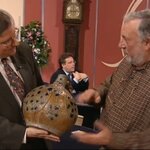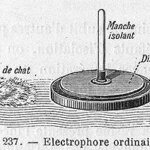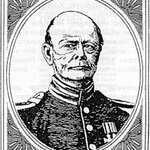Science History

A few days ago, I was watching an episode of the Antiques
Roadshow. People were bringing their treasured objects for expert
examination to the grounds of a stately house in St Ives, Cambridgeshire. The
items included an early pocket calculator by Sinclair (made locally), and a
traction engine arrived in full steam. But my ears really pricked up when a
valuable jug bought for a fiver (in today’s money, perhaps $50) was identified
as a Bellarmine Jug.
Galileo faced two main episodes of
opposition to his Copernicanism. The most famous one is his trial when Pope…

Amy Harmon's excellent, recent article in the New York Times describes how the Florida orange juice industry may soon be wiped-out because of a new bacterial disease spread by an introduced insect. It looks like there could be a technology-fix for the problem using genetic engineering. The question is whether the growers will get to apply that solution.
Coffee Rust - later these infected leaves fall off
The sort of crisis situation now facing the Florida orange industry is not at all unique in the history of farming. There have been many times when some new pest …
The contrarian in me forces me to argue against sides I would ordinarily agree with when the argument is made from a flawed premise; California's Proposition 37 got a thumbs down from me because there's no reason a terrifically unhealthy Whole Foods organic cupcake should have zero ingredient labeling requirements while a cupcake mix you buy in a store should have a warning label - the Whole Foods organic cupcake is far less healthy in every way.
But people are convinced organic food is somehow more nutritious. In culture, some myths become so entrenched that Google searches do no good in…

Electric Batteries - by A. Volta
In this article I present my translation of Alessandro (Alexander) Volta's original French paper, which I published as -Batteries électriques - By A. Volta
Volta's batteries are of a type now known as electrochemical batteries, to distinguish them from the prior class of electrostatic batteries as described by Benjamin Franklin in his letter to Peter Collinson of 1749. The 'Cavallo electrometer' mentioned by Volta can be seen at sparkmuseum.com. The electrophorus which he mentions is a capacitive charge generator. Invented by Johan Carl…

Batteries électriques - by Alexander VoltaIn 1800 the Royal Society published Alexander Volta's description of how he built his batteries.
It is not widely known that Volta invented both the 'wet' and the 'dry' battery. Most writers mention Volta's pile - a 'dry' battery, but omit to mention his 'crown of cups', or 'wet' battery.
Volta described his inventions as electric batteries: a term already in common use among scientists to denote series-connected condensers (capacitors) such as the Leyden jar. Volta's own term for his invention was artificial electric organ (organe…

News (?), Top-Secret (?), Latest revelation (?)Strange, the EU was aware of the NSA (spying) global gathering of electronic data since 2001. Sorry folks, this is not news. I wrote about this several years ago in this forum under the title: Quantum Physics; Humor, Sensationalizing, Hard Science, Espionage
Part of this post is quoted below.
"Espionage-
The point of this research is secure - quantum cryptography, quantum communication and quantum computing. What has developed is a quantum "arms race" among national groups that should be cooperating. On one side the English…

In A. D. 1300 in Poland, more precisely in the region of Kashubia, was coined the term "nachzehrer" to define the female vampire, or "chewing the shroud" or "devourer of the night."
The Nachzehrer would be a special kind of vampire who lives in a constant state of numbness in his grave, without understanding what is happening around and just like a child, chewing spasmodically his dress.
Martin Böhm wrote in 1601: "We have seen in times of the plague how dead people especially women - who have died of the plague make smacking noises in their graves, like a pig that is eating, and that…

Most people, including many scientists and electrical engineers, have never heard of Wilhelm Josef Sinsteden. He invented the lead-acid battery and published his findings in 1854. In 1860 an improved construction by Gaston Raimond Planté was the first commercially viable version. It is probably the wide marketing and adoption of the Planté cell which has led to so many books and articles - even a majority of scientific papers - stating that Planté invented the first of these batteries, usually giving 1859 as the date.
The historical fact is that Sinsteden's invention…

I was watching the recent two-part BBC series Bill Bailey’s Jungle Hero, about Alfred Russel Wallace (1823 – 1913), in which Bailey and his hidden camera team travelled through Indonesia sampling the joys of the rainforest while following the great naturalist’s journey. The first episode was spent on Borneo, the second on Sulawesi and the Spice Islands. Wallace spent considerable time in Borneo, and wrote On the Law Which Has Regulated the Introduction of New Species (published 1855) — not quite natural selection, but definitely evolution with transitional forms. This became…

Legendary Confederate fighter Thomas J. "Stonewall" Jackson died 150 years ago but the actual cause of his death has been a subject of debate. And it was again at the 20th annual Historical Clinicopathological Conference in Maryland.
Jackson got the nickname "Stonewall" from Confederate General Barnard E. Bee, when he moved an artillery battery up to support Bee's troops as they retreated at the First Battle of Bull Run (called First Manassas by Confederate troops)(1). Bee said of the mostly unheralded Colonel, "There is Jackson standing like a stone wall. Let us determine to die here, and we…